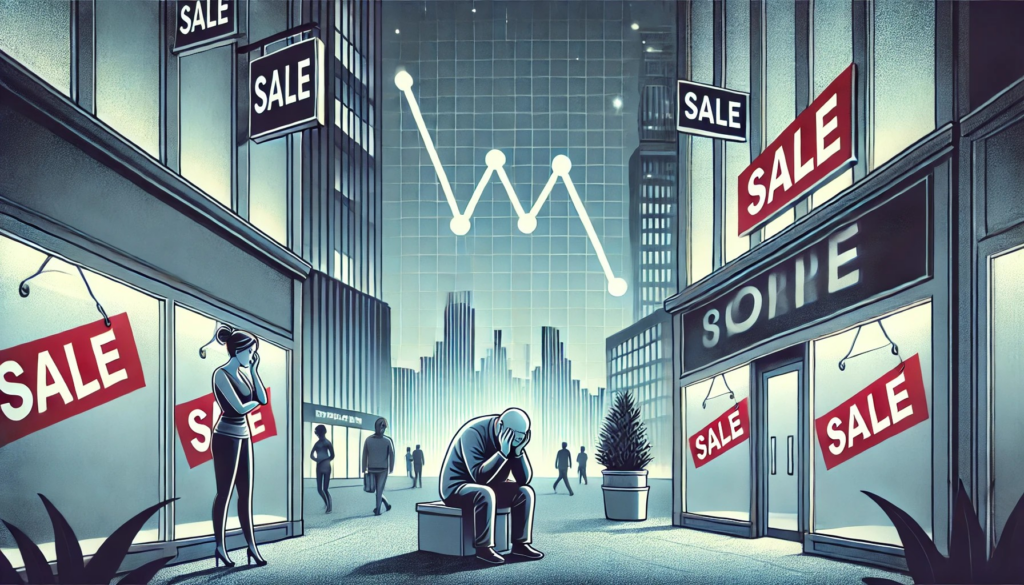S&P 500: -0.98% DOW: .96% NASDAQ: -3.60% 10-YR Yield: 4.21%
What Happened?
Last week on Wall Street was anything but smooth. Investors were met with a wave of disappointing news, including record-low consumer confidence, weaker-than-expected manufacturing and service data, and underwhelming guidance from major producers. This combination of factors left the markets searching for a spark of optimism.
All eyes turned to Nvidia’s earnings report and the Fed’s upcoming PCE (Personal Consumption Expenditures) data, both carrying the potential to shape market sentiment. Nvidia did not disappoint, exceeding expectations for the 21st consecutive quarter. Given its significant weight within the S&P 500, Nvidia’s strong performance was seen as a beacon of resilience, boosting investor confidence and signaling strength in U.S. trade partnerships.
However, the outlook wasn’t entirely rosy. Nvidia’s future earnings forecasts were tempered by the impact of tariffs implemented during the Trump administration, intensifying competition from major tech companies developing their own chips, and restrictive trade policies limiting Chinese imports.
Meanwhile, the PCE data offered the markets a moment of reprieve. Analysts largely anticipated higher inflation readings, following other inflationary indicators in recent weeks. These reinforced expectations of potential rate cuts, with growing confidence in the possibility of two rate cuts in 2025, possibly as early as June.
The Federal Reserve finds itself in a delicate balancing act. On the one hand, the cooling economy points to the need for rate cuts as a stimulus measure. On the other, uncertainties surrounding finalized tariff policies and their economic impact require the Fed to remain vigilant and adaptable.
Below we’ll go more in-depth on recent PCE data & Consumer spending, we will also discuss recent information on GDP reports!

VIEW January PCE inflation no surprise, cools year on year
- PCE for January was 2.5%, matching expectations, just slightly higher than the Fed’s target.
- Consumer spending decreased by 0.2% in January, the first decrease since March 2023.
- Personal income increases 0.9% in January.
The key takeaway – The Fed’s preferred measure of inflationary data, The U.S. Commerce Department’s Personal Consumption Expenditures (PCE) price index dropped this morning and on an annual basis, the PCE price index rose by 2.5% in January, slightly easing from December’s 2.6% increase and aligning with economists’ expectations. This news provided some reassurance on the heels of hotter-than-expected inflation data earlier this month. Regardless, consumer spending is still in a slump, which many analysts attribute to DOGE cuts, deportations in the U.S. and bad January weather. Consequently, a decrease in spending and a persistently sticky inflation rate signals a cooling economy and even the results of potential stagflation.
The report included softer consumer spending and slower income growth, potentially adding to the Fed’s watchlist of things to consider for future rate cuts to warm up the waters for the economy. In result, markets are optimistic and are currently pricing them in for as soon as June. However, Federal Reserve Chair Jerome Powell has indicated a cautious approach, emphasizing the need for clear evidence of sustained inflationary pressure before implementing policy changes. Additionally, President Donald Trump’s announcement of impending tariffs on imports from Mexico and Canada, set to take effect next week, introduces further uncertainty. These trade policies could lead consumers to accelerate purchases in February to avoid potential price increases, potentially impacting upcoming spending reports.

Consumer confidence plunges most in nearly 4 years as inflation fears escalate on Trump tariff threats
- Largest monthly decline in nearly four years (-11%).
- Present Situation Index fell to 136.5 from 139 last month.
- The Expectations Index fell to 72.9 from 82 last. A reading below 80 signals a recession for that year.
- Average 12-month inflation expectations jumped from 5.2% – 6%.
The key takeaway – Recent economic indicators reveal a significant decline in consumer confidence, primarily attributed to escalating inflation concerns and the Trump administration’s tariff policies. In February, the Conference Board’s consumer confidence index experienced its sharpest drop in nearly four years, falling 7 points to 98.3. This decline reflects growing anxiety among Americans regarding potential negative economic impacts from current policies.
The administration has implemented a 10% tariff on Chinese imports and plans to impose a 25% levy on goods from Mexico and Canada. These measures have raised concerns about increased consumer prices and potential economic slowdown. Additionally, unprecedented layoffs of federal workers have further dampened consumer sentiment, posing risks to spending, a key driver of the economy.
These reports may signal a potential increase in inflation, as many analysts report, but despite these challenges, the U.S. economy remains fundamentally strong, with robust job growth and increasing durable goods orders. However, the disconnect between economic indicators and consumer sentiment suggests that while current conditions are stable, there is widespread apprehension about future economic stability. Thus, are retail investors letting their risk-adverse mindset get the best of them, or are their sour opinions warrented?

Weekly jobless claims jump to 242,000, more than expected in latest sign of economic softening
- U.S. expanded at a seasonally adjusted annual rate of 2.3%, less than 2.6% expected.
- For all of 2024, the economy grew 2.8%, down just slightly from a 2.9% clip the previous year.
- Affluent families disproportionately take up share of consumer spending.
- 2.2% GDP growth forecasted for this year.
The key takeaway – In 2024, the U.S. economy demonstrated resilience and managed to grow at a decent clip. With the Gross Domestic Product (GDP) expanding by 2.8%, slightly below the 2.9% growth observed in 2023. This growth was primarily driven by robust consumer spending, which saw a notable increase of 4.2% in the fourth quarter—the most significant rise since early 2023.
However, this surge in consumer activity coincided with a concerning escalation in credit card debt. By the third quarter of 2024, outstanding credit card balances reached a record $1.17 trillion, with the national average debt per cardholder standing at $7,236. Delinquency rates also climbed, with the rate for credit card balances hitting 9.1%, the highest in over a decade.
Analysts attribute part of the increased spending in the latter part of the year to recovery efforts following severe hurricanes in the southern regions of the country. This disaster-induced expenditure provided a temporary boost to economic activity.
The Federal Reserve faced a complex policy environment. Despite inflationary pressures, the central bank opted to pause further interest rate cuts in January 2025. This decision was influenced by the Trump administration’s implementation of substantial tariffs and stringent immigration policies, which introduced uncertainties regarding their potential impact on inflation and overall economic growth. Some analysts express concern that these policies could exacerbate inflationary trends, potentially prompting the Fed to consider rate cuts to stimulate spending.
Conversely, persistently high mortgage rates, increased government spending, a slowdown in business inventory accumulation, and a decline in business investments suggest limited justification for the Fed to initiate rate cuts.
From Around the Watercooler

- Trump on a $250 bill? GOP lawmaker’s currency proposal faces roadblock
- Trump-Zelenskyy Oval Office meeting explodes into shouting match
- Trump’s proposed ‘gold card’ visa comes with a hidden tax break for the wealthy
- The first quarter is on track for negative GDP growth, Atlanta Fed indicator says
- Meta Is Looking to Get Into the AI Humanoid Robot Business



Comments are closed